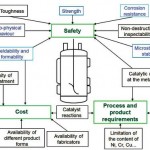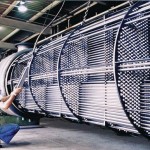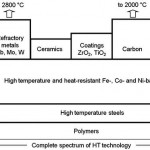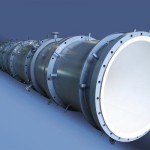An array of materials are available for the construction of equipment, pipelines and components in the chemical industry. In addition to pure metallic and non-metallic designs, there are numerous combinations of both material types that enable safe and efficient plant operation.
The authors: Dr. Albert Tulke Senior Expert, Competence Centre Manufacturing Support Services, Bayer Technology Services Helmut Diekmann Head of the Competence Centre Manufacturing Support Services, Bayer Technology Services
Along with the process design, the choice of materials is of particular importance when designing chemical equipment. A material selection process based solely on the functional and application requirements of the components is inadequate, however, if the necessary production processes are ignored.
As a result of these processes, it is not only important to achieve specific material properties; negative effects on the behaviour of the components under operational stresses must also be expected. The optimal materials for chemical equipment must therefore be derived from the sum of all requirements arising from the operational function and the production processes while simultaneously taking account of economic aspects.
The ever stricter specifications for the operation of chemical plants, the mounting complexity of the production processes, the growing number of materials and the need for cost-efficient manufacturing call for a systematic approach to the complex task of material selection. The scheme shown here is suited as a basic material selection system for chemical equipment; the often obligatory process development tasks are also considered. The diagram makes it clear that both application and production-related requirements need to be examined in as much depth as possible, to enable the demands on the material to be determined accurately and translated into verifiable material properties. On the other hand, the behaviour of a material must be known in the context of the production processes and plant operating conditions in order to predict its suitability for the intended application reliably.
It is plain that the above preconditions for optimum material selection are frequently impossible to meet adequately. For this reason, prototype and series experiments are generally necessary to provide test data upfront of a decision. In relation to chemical equipment, it is particularly difficult to grasp and consider the combination of mechanical and – often very complicated and therefore easily misunderstood – chemical loads, which in many cases also coincide with wear loads.
It is not uncommon for corrosion behaviour to emerge as the decisive criterion for the choice of materials, because this directly influences the safety of the equipment, component or pipeline. The wall thickness, and therefore the strength of the component, can be reduced by the corrosive action. This leads to a risk of leakage or cracking. Furthermore, selective or local corrosion forms exist which can also affect the integrity of the plant and cause the product to escape. The uncontrolled occurrence of corrosion can have particularly severe consequences in pressurised equipment. The use of non-resistant materials may additionally result in contamination of the product with corrosion products, thus changing the product properties or having other unwanted effects.
Temperature has a significant influence on the extent to which materials can be mechanically loaded. This becomes evident if chemical equipment is divided into ambient service, hot service and cold service groups and the material strength values utilised for the equipment strength calculation are examined.
With cold-service chemical equipment, the material strength is independent of the calculation temperature; by contrast, at ambient temperature it is calculated for steels based on the guaranteed minimum value of the 0.2 % strain or yield strength, even though it is well known that these strength values increase as the temperature decreases. At the same time, the toughness behaviour of the steel determines the minimum application temperature, in view of the higher brittle fracture risk at low temperatures.
In high-temperature applications, the critical factors for the suitability of materials are structural stability, strength and corrosion resistance. The maximum application temperature for polymeric materials is approximately 250 °C while heat-resistant steels can be used up to 550 °C. The allowable range for heat-resistant and high-temperature iron-, cobalt- and nickel-based alloys ends at 1200 °C. Refractory metals such as niobium, tungsten and molybdenum can be used at temperatures above 1200 °C as well as ceramics, carbon and various coating types.
Metallic materials
In practice, the majority of demands made by the chemical process industry can be satisfied by the standard grades of austenitic chrome-nickel-(molybdenum) stainless steels, which exhibit sufficient corrosion resistance. Nevertheless, materials with special qualities are unavoidable for certain types of application. Work on chemically resistant steels has so far concentrated on the development of austenitic and ferritic-austenitic types with a higher chrome and molybdenum content. In addition to good resistance against general corrosion, these materials have to display markedly improved permanence in aqueous media containing chloride ions, i. e. they must offer superior resistance to pitting, crevice and stress corrosion cracking.
At high concentrations of aggressive agents or high temperatures, nickel-based alloys represent an attractive alternative. The nickel-based alloys most popularly used in the chemical industry are the B and C types. However, there are also processes that place exceptionally high demands on the corrosion resistance of the materials. In these instances, special materials such as graphite, tantalum or zirconium may be preferred. Compared to standard steels, these materials involve substantially higher material and processing costs. Yet in spite of this, they are still the material of the choice for certain applications.
Non-metallic materials
A large number of materials are utilised in the manufacture of polymers. Polymers are divided into elastomers (NR, NBR, CR), thermoplastics (PE, PP and PTFE) and thermosetting types (Bakelite, epoxy resins). Three basic types of application are differentiated, namely solid, lining and coating. Thermoplastics or thermosetting and composite materials, amongst others, are suitable for solid construction while elastomers/rubbers, thermoplastics and thermosetting polymers are used for linings. Polymeric coatings are comprised, for example, of reactive resins – either with or without strengthening additives – and thermoplastic powders.
Combinations with metallic materials are very common. Polytetrafluoroethylene (PTFE) is often used as a lining for equipment because it exhibits extremely high corrosion resistance compared to other plastics.
Online-Info: www.cpp-net.com/0311433
Share:










